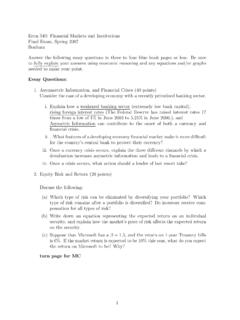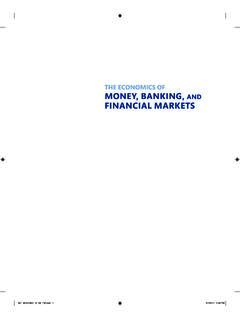Transcription of Chapter 1 -- An Introduction To Financial Management
1 1 Chapter 1 -- An Overview of Financial Management What is finance: cash flows between capital markets and firm s operations The goal of a firm Forms of business organization Intrinsic value and market price of a stock Important business trends Business ethics Agency problem Career opportunities in finance What is finance: cash flows between capital markets and firm s operations (2) (1) Firm s Capital Operation Financial (4a) Markets (Real Assets) Managers ( Financial (3) (4b) Assets) (1) Cash raised by selling Financial assets in Financial markets (2) Cash invested in firm s operations and used to purchase real assets (3) Cash generated from firm s operations (4a) Cash reinvested in firms operations (4b)
2 Cash returned to investors Financing decisions vs. investment decisions: raising money vs. allocating money Activity (1) is a financing decision Activity (2) is an investment decision Activities (4a) and (4b) are financing decisions The role of a Financial manager Forecasting and planning of firms Financial needs Making financing and investment decisions Coordinating with other departments/divisions Dealing with Financial markets Managing risks 2 Finance within an organization: importance of finance Finance includes three areas (1) Financial Management .
3 Corporate finance, which deals with decisions related to how much and what types of assets a firm needs to acquire, how a firm should raise capital to purchase assets, and how a firm should do to maximize its shareholders wealth - the focus of this class (2) Capital markets: study of Financial markets and institutions , which deals with interest rates, stocks, bonds, government securities, and other marketable securities. It also covers Federal Reserve System and its policies. (3) Investments: study of security analysis, portfolio theory, market analysis, and behavioral finance The goal of a firm To maximize shareholder s wealth (or firm s long-run value) Why not profit or EPS maximization?
4 Profit maximization usually ignores timing and risk of cash flows EPS sometimes can be manipulated or misleading 3 Forms of business organization Proprietorship: an unincorporated business owned by one individual Advantages: Easy and inexpensive to form Subject to less government regulations Lower income taxes Disadvantages: Unlimited personal liability Limited lifetime of business Difficult to raise capital Partnership: an unincorporated business owned by two or more people Advantages vs. disadvantages: similar to those of proprietorship, in general Corporation: legal entity created by a state Advantages: Limited liability Easy to transfer the ownership Unlimited lifetime of business Easy to raise capital Disadvantages: Double taxation (at both corporate and individual levels) Cost of reporting S Corporation: allows small business to be taxed as proprietorship or partnership Restrictions: no more than 100 shareholders.
5 For small and privately owned firms Limited Liability Company (LLC) and Limited Liability Partnership (LLP): Hybrid between a partnership and a corporation - limited liability but taxed as partnership LLPs are used in professional fields of accounting, law, and architecture while LLCs are used by other businesses Intrinsic value and market price of a stock Intrinsic value is an estimate of a stock s fair value (how much a stock should be worth) market price is the actual price of a stock, which is determined by the demand and supply of the stock in the market 4 Determinants of intrinsic value and stock price Intrinsic value is supposed to be estimated using the true or accurate risk and return data.
6 However, since sometimes the true or accurate data is not directly observable, the intrinsic value cannot be measured precisely. market value is based on perceived risk and return data. Since the perceived risk and return may not be equal to the true risk and return, the market value can be mispriced as well. Stock in equilibrium: when a stock s market price is equal to its intrinsic value the stock is in equilibrium Stock market in equilibrium: when all the stocks in the market are in equilibrium ( for each stock in the market , the market price is equal to its intrinsic value) then the market is in equilibrium 5 Actual prices vs.
7 Intrinsic values When the intrinsic value of a stock is higher than the market price of the stock, we say that the stock in the market is under-valued (under-priced) For example, if the intrinsic value for a stock is $26 and the market price is $25, then the stock is under-valued. When the intrinsic value of a stock is lower than the market price of the stock, we say that the stock in the market is over-valued (over-priced) For example, if the intrinsic value for a stock is $30 and the market price is $32, then the stock is over-valued.
8 When the intrinsic value of a stock is equal to the market price of the stock, we say that the stock in the market is fairly priced (the stock is in equilibrium) Important business trends Globalization Improving information technology Corporate governance 6 Business ethics Standards of conduct or moral behavior toward its employees, customers, community, and stockholders - all its stakeholders Measurements: tendency of its employees, adhere to laws and regulations, moral standards to product safety and quality, fair employment practice, fair marketing and selling practice, proper use of confidential information, community involvement, and no illegal payments or practice to obtain business Agency problem A potential conflict of interest between two groups of people Stockholders vs.
9 Managers Instead of shareholders wealth maximization, managers may be interested in their own wealth maximization Incentives: Performance shares, executive stock options (positive) Threat of firing, hostile takeover (negative) Stockholders vs. bondholders Stockholders prefer high-risk projects for higher returns Bondholders receive fixed payment and therefore prefer lower risk projects Career opportunities in finance Banking Investments Insurance Corporations Government Exercise ST-1 Questions: 1-8 7 Chapter 2 -- Financial Markets and institutions Capital allocation process Financial markets Financial institutions The stock market and stock returns Stock market efficiency Capital allocation process The process of capital flows from those with surplus capital to those who need it Three types of transfer (1) Direct transfer: a business sells its security directly to investors (2) Indirect transfer through an investment banker.
10 A business sells its security to an investment banker, which in turn sells the same security to individual investors (3) Indirect transfer through a Financial intermediary: a Financial intermediary obtains funds from investors by offering its own securities and uses funds to buy other business securities Capital formation process 8 Financial markets Physical asset market vs. Financial asset markets Physical asset markets are markets for real (or tangible) assets Financial asset markets are markets for Financial assets - focus of this class Money markets vs.













